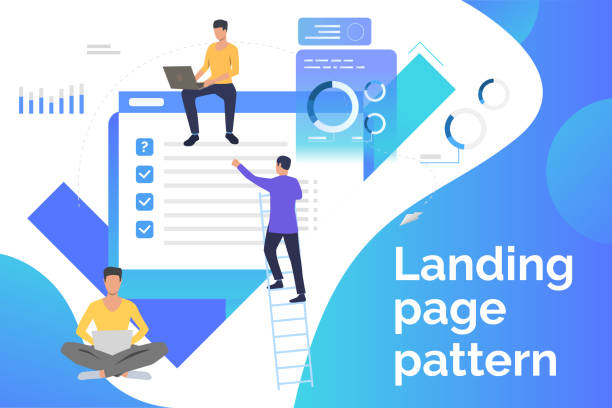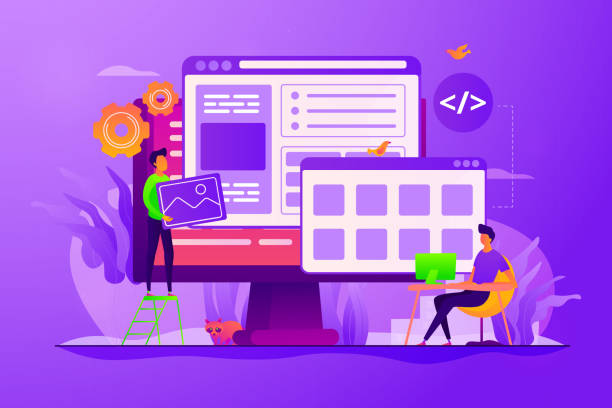The Importance of Speed in Today’s Website Design

In today’s fast-paced world, #website speed is not just a competitive advantage, but a necessity. Internet users have high expectations for page loading times, and even delays of a few seconds can lead to the loss of potential visitors and customers. Fast website design has become more important than ever, as it directly impacts user experience (UX) and SEO ranking. A slow site can increase the bounce rate and damage your brand’s credibility. On the other hand, a fast-loading website encourages users to spend more time on your site and visit other pages. This is especially crucial for e-commerce websites, where every second of delay can mean lost sales. Google and other search engines also consider site speed as one of the important factors in ranking search results. This is important news for any business looking to be seen online. Therefore, attention to fast website design should be a priority for every web project. This is not just a technical point, but a business strategy that can significantly increase your return on investment.
Losing potential customers due to an unprofessional website? Rasawweb is your answer! With our specialized corporate website design services:
✅ Enhance your business’s credibility and position
✅ Experience attracting more targeted customers
⚡ Act now for a free consultation!
Key Factors Affecting Your Website Speed

To achieve fast website design, identifying and optimizing key factors affecting loading speed is essential. One of the most important factors is optimizing images and media. High-volume images can severely increase page loading time. Using appropriate formats (such as WebP) and smart image compression is an important step in improving speed. Another factor is code optimization; heavy and uncompressed CSS and JavaScript files can create major bottlenecks. Minification and combining these files help reduce HTTP requests and improve speed. Choosing appropriate hosting also plays a vital role. Shared hosting usually has lower speeds than virtual private servers (VPS) or dedicated servers. Using Content Delivery Networks (CDN) to distribute content worldwide and reduce latency is also very effective. The number of plugins and extra scripts can also slow down the site; therefore, only install essential plugins and use their lightweight and optimized versions. Database optimization, cache activation, and using HTTP/2 protocol are other important factors in fast website design. Understanding these specialized factors will help you create a comprehensive strategy to increase your website’s speed.
The Role of Image and Media Optimization in Site Speed
![]()
Optimizing images and media is one of the most effective steps towards fast website design. Images and videos often constitute the largest portion of a web page’s size and can significantly impact loading time. To begin, optimized image formats like WebP should be used, which has a smaller file size than JPEG or PNG while offering similar quality. Compressing images without noticeable quality loss is also a key technique. Online tools and CMS plugins like WordPress are available for this. Also, image dimensions should be adjusted to suit their display location on the website; loading an image with dimensions much larger than what is displayed on the screen is merely a waste of bandwidth and time. Using lazy loading (Lazy Loading) for images and videos means that media only load when the user scrolls to the relevant section, which significantly accelerates initial page loading. These guidelines help developers adopt an effective approach to media optimization. A website with optimized images provides a much better user experience and contributes to better search engine rankings.
| Format | Advantages | Disadvantages | Recommended Use |
|---|---|---|---|
| JPEG | Suitable for photos, good compression | Quality degrades with each re-compression, no transparency support | Detailed photos, background images |
| PNG | Supports transparency, no quality loss | Larger file sizes for photos | Logos, icons, images with transparency |
| GIF | Supports animation, low size for simple images | Limited color palette (256 colors), low quality for photos | Simple animations, icons |
| WebP | Much smaller size with similar quality to JPEG/PNG, supports transparency and animation | Not fully supported by older browsers | Optimal replacement for JPEG and PNG in most cases |
The Importance of Hosting and CDN in Accelerating Web Loading

The role of hosting (web hosting) and Content Delivery Networks (CDN) in fast website design is undeniable. Choosing a quality hosting service appropriate for your website’s needs forms the foundation of website speed. Shared hosting (Shared Hosting) is cheaper but shares server resources with other websites, which can lead to slower speeds during peak loads. In contrast, Virtual Private Servers (VPS) or Dedicated Servers guarantee more resources and are more suitable for high-traffic websites. The physical location of the hosting server also matters; the closer the server is to your target audience, the lower the latency and the faster the loading speed will be. In addition to hosting, using a CDN can significantly improve user experience. A CDN stores your website’s static content (such as images, CSS, JavaScript) on multiple servers worldwide. When a user visits your website, the content is delivered from the closest CDN server to them, which minimizes physical distance and loading time. This combination of powerful hosting and CDN is a specialized strategy to ensure fast website design on a global scale and is one of our most important recommendations.
Does your company’s website perform as it deserves for your brand? In today’s competitive world, your website is your most important online tool. Rasawweb, a specialist in professional corporate website design, helps you to:
✅ Build credibility and customer trust
✅ Convert website visitors into customers
⚡ Get a free consultation now!
Optimizing HTML, CSS, and JavaScript Code

Optimizing HTML, CSS, and JavaScript codes are among the fundamental steps in fast website design. Disorganized, excessive, or heavy code can severely impact page loading time. The first step is “Minification” of these files, meaning all whitespace, comments, and extra characters are removed from the code to reduce file size. This does not affect code functionality but reduces its size for transfer from the server to the user’s browser. The next step is “Concatenation” of files; merging multiple CSS or JavaScript files into a single file can reduce the number of HTTP requests, which in turn improves speed. Also, ensure that render-blocking JavaScript codes are moved as much as possible to the end of the <body> tag or that defer and async attributes are used so that the main page content loads sooner. Using Inline CSS (Inline CSS) for above-the-fold content and asynchronous loading (Asynchronous loading) for the rest of the CSS can also be beneficial. These specialized measures, though they may seem complex, play a very important role in optimizing website performance and achieving fast website design. This is an analytical approach to improving web efficiency.
Caching Strategies for Performance Improvement

Effective use of caching (Caching) is one of the most powerful strategies for achieving fast website design. Caching refers to the process of temporarily storing website data so that for subsequent visits, there is no need to fully reload from the server. This significantly reduces loading time for returning visitors and also lessens the load on the server. There are different types of caching, each applied at different levels of the website:
- Browser Caching: The user’s browser stores static files (such as images, CSS, JavaScript). On subsequent visits, the browser does not need to download these files again.
- Page Caching: A complete version of the generated HTML page is stored to be served directly from the cache on subsequent requests, without the need for re-processing by the server.
- Database Caching: Results of database queries are stored to prevent re-execution of the same queries.
- Object Caching: Results of more complex PHP operations are stored.
Proper configuration of caching rules on the server and using appropriate caching plugins for Content Management Systems (CMS) like WordPress can dramatically increase your website’s speed and improve user experience. These guidelines are crucial for achieving a very fast and efficient website.
Mobile Responsiveness and Its Impact on Speed

In today’s era, where most users connect to the internet via mobile devices, mobile responsiveness (Mobile Responsiveness) and its impact on fast website design have gained special importance. A responsive website means that its design and content automatically adjust to the screen size of the user’s device (mobile, tablet, desktop). This not only improves user experience but is also crucial for SEO, as Google prioritizes mobile-friendly websites. But beyond appearance, loading speed on mobile is a major challenge. Mobile internet connections can be less stable and slower than desktop, so every small optimization has a significant impact.
To ensure high speed on mobile, in addition to general speed optimizations, more specialized points should also be considered: using “Mobile-First” designs, optimizing fonts for faster loading, reducing the number of HTTP requests on mobile, and ensuring that heavy scripts do not prevent the main content from loading on small devices. Tools like Google PageSpeed Insights, Lighthouse, and GTmetrix provide accurate analytical insights into your website’s performance on mobile and identify weaknesses. Fast website design for mobile means paying attention to technical details as well as providing a flawless user experience.
| Metric | Description | Good Threshold |
|---|---|---|
| LCP (Largest Contentful Paint) | Time it takes for the largest content element visible in the viewport to load | Under 2.5 seconds |
| FID (First Input Delay) | Time from the user’s first interaction to the browser’s response | Under 100 milliseconds |
| CLS (Cumulative Layout Shift) | Amount of unexpected layout shifts in content | Under 0.1 |
Tools and Techniques for Measuring Website Speed

To ensure that your efforts in fast website design have been fruitful, regularly measuring and monitoring website speed is crucial. Fortunately, powerful tools exist for this purpose to help you identify weaknesses and implement necessary improvements. One of the most popular of these tools is Google PageSpeed Insights, which not only provides a score for your site’s speed on desktop and mobile but also offers specific recommendations for performance improvement. Another widely used tool is GTmetrix, which gives you detailed information on the loading time of each element, a Waterfall chart, and Performance and Structure reports. Also, Lighthouse, integrated into the Chrome browser, allows for assessing performance, accessibility, best practices, SEO, and PWA (Progressive Web App).
These tools, in addition to providing overall scores, also show details such as Time to First Byte (TTFB), First Contentful Paint (FCP) and Largest Contentful Paint (LCP), which help in more precise analysis of bottlenecks. Using these tools is a practical and essential guide for anyone looking for fast website design and its continuous optimization. Regular speed monitoring allows you to identify and resolve potential issues before users experience them. This educational section helps you look at website speed from a more specialized perspective.
Losing potential customers due to an unprofessional website? Rasawweb is your answer! With our specialized corporate website design services:
✅ Enhance your business’s credibility and position
✅ Experience attracting more targeted customers
⚡ Act now for a free consultation!
The Impact of Fast Websites on SEO and User Experience

One of the most important questions regarding fast website design is its impact on SEO and user experience. The emphatic answer is that it has a very positive and profound impact. From an SEO perspective, search engines like Google consider website speed as an important ranking factor. A slow website can directly negatively affect your ranking in search results, and conversely, a fast website has a better chance of higher rankings. This has become even more important, especially after recent Google updates like Core Web Vitals.
But the impact of fast website design goes beyond search algorithms. User experience (UX) is highly dependent on loading speed. Today’s users are impatient, and if a website doesn’t load in a few seconds, they are likely to leave it and go to your competitors. This leads to an increase in bounce rate (Bounce Rate) and a decrease in user engagement. In contrast, a fast website increases user satisfaction, improves engagement, increases time spent on the site and a higher probability of converting a visitor to a customer. This is a thought-provoking question: Is your business ready to lose customers due to slow speed? Investing in fast website design is not just a technical investment, but a strategic investment in the future of your business that yields significant returns in improving SEO and customer satisfaction.
Future Trends in Fast Website Design and Maintenance

With technological advancements and changing user expectations, new trends in fast website design are emerging that every developer and website owner should pay attention to. One of these trends is the increasing use of Progressive Web Apps (PWAs). PWAs offer a native app-like experience in the browser, with capabilities such as offline loading, push notifications, and extremely high speed. This technology promises a future where websites will not differ much from applications in terms of speed and performance.
Another trend is optimization for smart devices and the Internet of Things (IoT), which requires websites with fewer resources and faster loading. Also, the emphasis on new protocols like HTTP/3, built on QUIC and offering higher speed for data transfer, will continue. Continuous image optimization with more advanced formats and even web-optimized videos will be an inseparable part of maintaining a fast website.
Artificial intelligence and machine learning will also play an increasing role in diagnosing and solving performance issues. Maintaining a fast website requires continuous monitoring, regular updates, and adaptability to emerging technologies. This is newsworthy and entertaining, as it shows how the future of the web is rapidly evolving and how we can lead these developments with fast website design.
Frequently Asked Questions
| Question | Answer |
|---|---|
| What is fast website design? | The process of building a website that loads quickly and provides a smooth user experience. |
| Why is website speed important? | Improved user experience, reduced bounce rate, increased conversion rate, and better search engine ranking (SEO). |
| What factors affect website speed? | Image size, number of HTTP requests, code optimization (HTML, CSS, JS), hosting speed, and browser caching. |
| How can website speed be improved? | Image optimization, file compression, caching, choosing suitable hosting, and reducing unnecessary plugins. |
| How do images affect website speed? | High-volume or improperly formatted images can severely increase page loading time. |
| What is the role of JavaScript and CSS in website speed? | Unoptimized, large, or render-blocking codes can reduce page rendering speed. |
| How much does hosting affect website speed? | The speed and quality of the hosting server directly impact website response time and initial loading speed. |
| What tools are available to check website speed? | Google PageSpeed Insights, GTmetrix, Pingdom Tools are common tools. |
| What are the benefits of a fast website? | Greater user satisfaction, reduced site abandonment (bounce rate), increased time on site, and improved ranking in Google results (SEO). |
| What are common mistakes that slow down a website? | Using unoptimized images, bulky and unorganized code, excessive use of plugins, and not using caching. |
And other services of Rasa Web advertising agency in the field of advertising
- Smart Conversion Rate Optimization: A fast and efficient solution for campaign management with a focus on attractive UI design.
- Smart Marketing Automation: A creative platform to improve customer acquisition with custom programming.
- Smart Social Media: A professional solution for customer acquisition with a focus on precise target audience targeting.
- Smart Digital Branding: A professional solution for analyzing customer behavior with a focus on SEO-driven content strategy.
- Smart Sales Automation: An effective tool to increase click-through rate by utilizing real data.
And over hundreds of other services in the field of internet advertising, advertising consultation and organizational solutions
Internet Advertising | Advertising Strategy | Advertorials
Sources
SEO Training and Website Speed Optimization with Ahrefs
10 Ways to Increase Website Speed and Improve Website SEO
Comprehensive Guide to Website Speed Optimization in WordPress and Laravel
The Importance of Site Speed for SEO and User Experience
? Are you looking for a big leap in your online business? Rasawweb Afarin, by providing comprehensive digital marketing services including fast website design and professional SEO, and social media management, paves your path to success. With us, experience a powerful and influential presence in the digital world.
📍 Tehran, Mirdamad Street, next to Central Bank, Southern Kazeroun Alley, Ramin Alley No. 6



